|
Friday, June 6
- Breakfast: blueberry-stuffed French toast
- Breakfast: chorizo and egg burrito
- Tuna melt
- Smart cuisine: white fish florentine
- Kielbasa and kraut
- Eggplant parmesan panino
- Cilantro lime chicken bowl
- Clam chowder
- Texas-style chili
- Assorted pizza by the slice
Wilson Hall Cafe menu
|
|
Friday, June 6
Dinner
Closed
Wednesday, June 11
Lunch
- Charmoula-marinated swordfish steaks
- Lime cilantro rice and sauteed pea pods
- Pineapple flan
Chez Leon menu
Call x3524 to make your reservation.
|
|
Stanislav Tokar named Scientist of the Slovak Republic for 2013
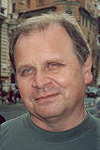 |
|
Stanislav Tokar
|
Last month, Fermilab user and CDF scientist Stanislav Tokar of Comenius University in Bratislava, was recognized as the 2013 Scientist of the Slovak Republic.
In the 17th annual competition, the Center for Scientific and Technological Information of Slovakia, the Slovak Academy of Science and the Association of Slovak Scientific and Technological Societies recognized five Slovak scientists, who received the 2013 awards.
The most prestigious of these went to Tokar for "significant and original contributions in high-energy physics, mainly for determination of the top quark charge."
Tokar, who began investigating the top quark charge in 2000, is also a member of the ATLAS collaboration at CERN. Tokar helped determine experimentally that the top quark has an electric charge of 2/3, in agreement with the Standard Model.
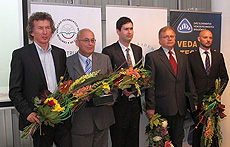 |
| Stanislav Tokar, second from right, receives the award for Scientist of the Slovak Republic. Photo courtesy of Stanislav Tokar |
|
Dennis Overbye moderates webcast panel discussion - today at 12:30 p.m.
Dennis Overbye, science journalist at The New York Times, will moderate a panel discussion on the global vision for the field of particle physics today at 12:30 p.m. Central time. The panel discussion, titled "The Road to Discovery," is part of the second annual Large Hadron Collider Physics conference, jointly hosted by Brookhaven National Laboratory and Columbia University.
Panelists include Nima Arkani-Hamed, Sergio Bertolucci, Jerry Blazey, Hitoshi Murayama, Steve Ritz and Natalie Roe. Also presenting are Fabiola Gianotti, Andrew Lankford and Jim Siegrist.
Submit a question for Overbye to ask the panelists. Watch a webcast of the event.
|
Network upgrades: building a superhighway
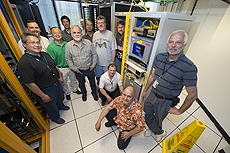 |
| This team is responsible for Fermilab's network upgrades, which will increase speed and prevent congestion, providing a superhighway for data traffic to get to its destination. Standing, from left: Ray Pasetes, Mark Kaletka, Wenji Wu, Liang Zhang, Matt Crawford, Mike Behnke, Maung Han, Vyto Grigaliunas, Andy Rader. Kneeling, from left: Andrey Bobyshev, Chuck Andrews. Standing in front: Phil Demar. Photo: Reidar Hahn |
Max Planck, the Nobel Prize-winning German theoretical physicist of quantum theory fame, said that science does not mean just accepting what is already known, but involves ceaseless effort and constant progress toward an unknown end. Whether detecting ghostly neutrinos after a 500-mile journey, searching the skies for supernovae as evidence of dark energy or ramping up toward a 14-TeV Large Hadron Collider, Fermilab scientists illustrate this concept by seeking higher energies, greater precision and larger experiments as they delve deeper into the mysteries of our universe.
The infrastructure supporting experiments must not only keep up with these ever-increasing needs; it must forge ahead. This principle underlies the current networking upgrades that require migrating ChiMAN network's eight 10-gigabit connections to ChiExpress's one 100-gigabit and three 10-gigabit connections. The project, [completed in] May, was coordinated with the Energy Sciences Network by Ray Pasetes, Network and Communication Services department head, Vyto Grigaliunas and Andrey Bobyshev from the Network Services group, and Phil Demar, Network Research group leader.
These changes will mean a huge rise in Fermilab's offsite bandwidth capacity. "Jobs will spend less time waiting for data to arrive and more time actually processing the data," says Pasetes. Network Services is implementing these changes before the ever-increasing demand outstripped resources. "We are trying to stay ahead [of experiment needs]," said Pasetes.
Read more
—Clementine Jones
|
Catching the sun
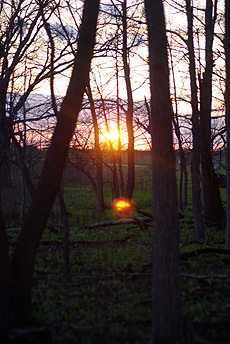 |
| The sun is reflected in a pool in the woods by Pine Street. Photo: Barb Kristen, PPD
|
|
How atomic particles helped solve a wine fraud mystery
From NPR, June 3, 2014
In a laboratory, deep under a mile-high stretch of the Alps on the French-Italian border, a physicist at the University of Bordeaux, is testing the authenticity of a bottle of wine.
"We are looking for radioactivity in the wine," says Hubert. "Most of the time the collectors send me bottles of wine because they want to know if it is fake or not."
First, Hubert takes the bottle in the hand and puts it close to a detector. After he closes the shielding, which blocks the radiation, he records the gamma rays. The level of those gamma rays emitted can often tell him something about when the wine was bottled. For example, if it was bottled before about 1945, there shouldn't be any cesium 137 — radioactive evidence of exploded nuclear bombs and the Atomic Age — in the wine.
Read more
|
|
Connecting the dots
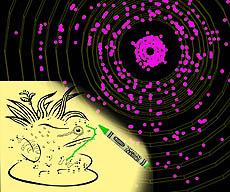 |
| Learning to connect the dots is one of the first artistic tasks a child accomplishes. In today's article, we learn how physicists accomplish the same task for a much more complicated puzzle.
|
When two protons collide in the center of the CMS detector, the collision energy can create hundreds of electrically charged particles. These particles roar through the apparatus, crossing individual detector elements. Each particle marks the location of its passage, leaving a string of dots that can be seen on a computer screen.
One of the trickiest jobs in particle physics is to teach a computer how to connect the dots and reconstruct the tracks of all of the particles that exited the collision. That's correct: The child's simple pastime of connect-the-dots can consume the efforts of many of the finest minds in an experiment like CMS. The difficulty stems from the fact that there are hundreds of tracks and that, in a bit of an inconvenient oversight, nobody bothered to put numbers beside the dots to tell the computer which to connect.
Reconstructing tracks is one of the first tasks that an experiment must accomplish in order to begin to analyze the data. Before the tracks are identified, the data is a mess of little dots. Once the tracks are determined, scientists can begin to sort out the physical process that occurred by figuring out that this particle went this way while another particle went that.
In addition to reconstructing the tracks of particles, scientists also reconstruct the origin of the particles. This is the location at which the collision between two protons occurred. Until you know the origin and trajectory of the particles, you can't even begin to understand what sort of collision was recorded.
CMS scientists have worked long and hard to develop the algorithms to accomplish these challenging tasks. In a recent paper, they described the result of their efforts. Particles leaving the collision at angles near 90 degrees measured from the beam can be reconstructed about 94 percent of the time. For the special case of isolated muons, the reconstruction probability rises to 100 percent. The location of the origin of the collision can be localized with a precision about 0.01 millimeters, or about half the size of the finest human hair. These algorithms are fast and flexible, and scientists continue to improve on them in anticipation of the resumption of operations in early 2015.
—Don Lincoln
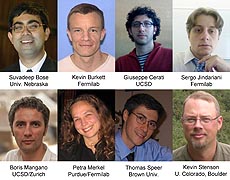 |
| These U.S. scientists contributed to this analysis.
|
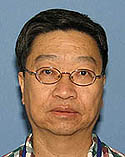 |
| The upgraded CMS tracking detector is based on the vision of our late colleague Simon Kwan.
|
|
Exterior window washing at Wilson Hall - June 9-13
Clorica Management workers will wash the exterior windows of Wilson Hall from June 9-13. Employees should take care when walking outside of Wilson Hall during these work days.
|
Particle physics: The hunt for Majorana neutrinos hots up
From Nature, June 4, 2014
Discovering a new class of fundamental particle is about the biggest bang you can make in particle physics. The discovery of the Higgs boson was so exciting partly because it is a fundamental particle with no spin, the first ever seen. Physicists have long tried to resolve whether the familiar neutrino actually belongs to a class of exotic entities called Majorana particles, which are their own antiparticles. Majorana neutrinos might also help to explain why neutrinos are so light, and could be a clue to how the Universe came to contain so much more matter than antimatter. Almost the only practical way to reveal Majorana neutrinos would be to observe the rare nuclear process called neutrinoless double-β decay. In a paper published on Nature's website today, the EXO-200 Collaboration announces the result of a high-sensitivity technique to search for this decay. Their results show the power of their technique, but demonstrate that there is still much work to do in the search for Majorana neutrinos.
Read more
|
|